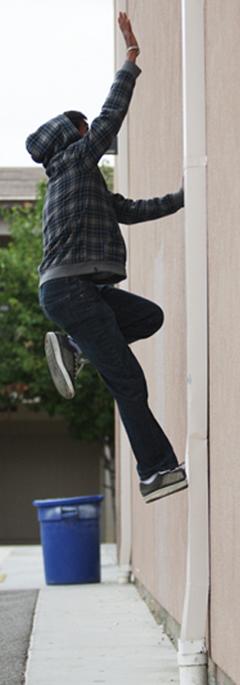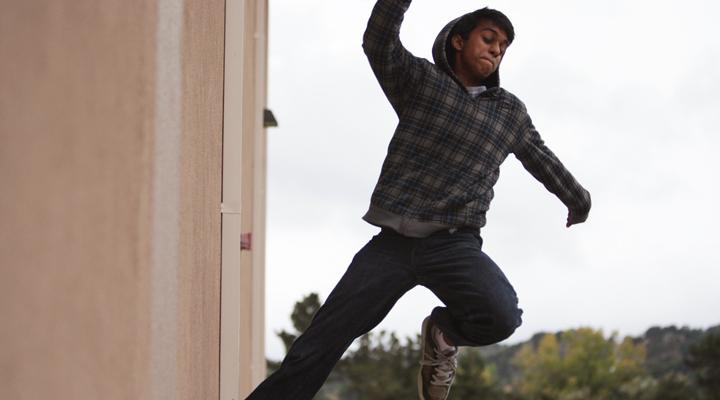
It is a Saturday afternoon, and his friends are probably studying or “Facebooking.” But junior Sai Mucharla is doing none of those things. Instead, he is jumping off a two-story building in San Jose.
This is not an act of pure insanity, but an example of his hobby. Running up walls, vaulting over poles, jumping off buildings — Mucharla has been doing parkour since the beginning of his sophomore year in 2010.
What is parkour?
“I can’t really describe it,” Mucharla said. “The point of parkour is to get from point A to point B in the most direct and fastest route possible.”
Previously, he had only seen parkour through Youtube videos. This might be the easiest way to explain the sport; as Mucharla points out, it is difficult to encapsulate this sport with words, and to see is to understand.
“You need forward movement, like throughout every move you do,” Mucharla said. “If you’re running a wall, you don’t want to stop and go straight up. You want to keep your momentum going … always pushing forward with your legs.”

Jumping in
While running laps in San Jose, he met several members of the Bay Area Parkour Club, an informal organization for parkour practicioners, called traceurs, of all skill levels. Intrigued by their flips, he decided to join the club.
Since then, Mucharla has been attending parkour sessions every month or so. The Bay Area Parkour Club is not an officially regulated organization, but a community-run group. As stated on the official website, members coordinate “ad hoc meet-ups” rather than carefully-organized congregations. These sessions are not structured lessons, but come-as-you-please opportunities for any parkour lovers in the area.
“First time I went, I didn’t even know I could get over a railing,” Mucharla said. “You have to experiment for the first few times … see how much muscle you have, how well you can use it, how comfortable you are with using it.”
Experienced traceurs are often on site and willing to help others train, which is how Mucharla got his foot in the game. He credits his current skill to field experience and experimentation rather than the couple of early training sessions.
Anyone watching would see Mucharla running up walls, sprinting to the next obstacle and occasionally flipping, a series of motion for three or four minutes. But compared to others who can keep up the nonstop action for up to an hour, Mucharla says he has a long way to go.
“I’m still very beginner-ish,” Mucharla said. “You see a lot of other guys, they’re doing a lot of amazing things. And I’m like the little peewee running behind.”
What it’s like
At 16 years old, Mucharla’s age sets him apart from the slightly older crowd at parkour sessions. But an observer would probably see no difference. He wears the right clothes — athletic shorts and shoes, but no shirt — and enthusiastically propels himself around the urban obstacles, just like anyone else.
“Some are college drop-outs, some are between jobs. Like half the guys don’t know what they’re doing, the other half is just stable, doing this for a hobby kind of thing,” Mucharla said. “You’d think they would treat you like you’re inferior but it’s actually quite the contrary. They treat you like equals in a sense. [The] atmosphere is friendly, very friendly.”
At times, the casual atmosphere is punctuated by 9-1-1 situations. Most traceurs are not first-aid certified, and injuries prove inevitable when people are vaulting around an abandoned three-story building.
“I actually don’t think it’s that safe … there’s no emergency waivers or emergency contacts, so if you get hurt it’s basically on the instructors to get you to a hospital,” Mucharla said. “[But] they always ask you to not overshoot your comfort zone, so I mean prevention-wise they’re good.”

Life on the edge
Every few months, Mucharla ends up going to school with a limp or a bandaged wrist. Close friends like junior Gavin Wong watch for these tell-tale signs of Mucharla’s latest parkour adventure.
“I kid you not, I just wait for that phone call or just wait for that time when [Mucharla’s] not present at school,” Wong said.
Few people know about Mucharla’s weekend night life. Those who do cannot usually picture him in such an extreme setting. Wong has known Mucharla since middle school and does not consider his parkour antics out of character, but still expressed surprise upon initial discovery of Mucharla’s hobby.
“I’m like, ‘Really Sai, you’re jumping off buildings now?’” Wong said. “I told him, ‘You shouldn’t do it,’ because he’s going to kill himself and I would be the one saying stuff at his funeral.”
His transformation
Even Mucharla confesses traces of surprise with his quirky hobby.
“In sixth grade, if I looked into the future and saw myself doing parkour, I’d be like, ‘Whoa, that’s not me,’” Mucharla said. “I was a band geek in sixth grade, walking around swagging with my trumpet case, with absolutely no physical activity.”
A certain dissatisfaction with his appearance led to a self-proclaimed transformation. Starting martial arts and wrestling, turning vegetarian — he reports losing about 40 pounds in seventh grade.
“I was really disappointed in how I looked because I was flabby,” Mucharla said. “I guessed I would feel better if I slimmed down, put some muscle on me, enjoyed sports, ate better. And surprise, it did.”
The escape
For Mucharla, parkour is not just a form of exercise, but a method of retreat.
“It’s nice to just get away from school, homework, house,” Mucharla said. “As you’re doing it, you don’t feel. It’s nice to know, ‘Oh, I can worry about that later.’”
And as he runs across the ground, what runs through his mind?
“Three things,” Mucharla said. “One, I want water. Two, I hope I don’t break my feet, and three, I’m glad I’m doing this.”
Check back for a related video of Mucharla in action.

This work is licensed under a Creative Commons Attribution 3.0 Unported License.








